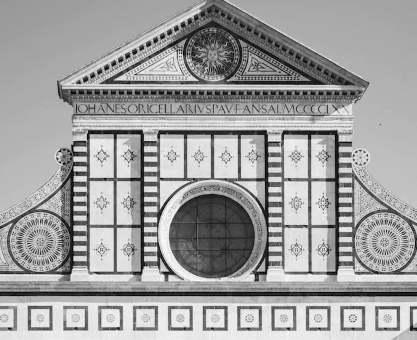The mere mention of this magnificent city brings to mind cobblestone streets, awe-inspiring architecture, and a rich tapestry of art that has captivated minds for centuries. At the heart of it all lies Santa Maria Novella, a stunning church, and the surrounding area that brims with artistic wonders.
Florence invites you with open arms, and if you’re carrying a suitcase or two, the Santa Maria Novella luggage spot is there to help. This spot is a gateway to exploration, allowing you to explore the area without lugging your bags around all day. While you may come to drop off your luggage, you leave with an essence of the Renaissance.
Artistic Marvels of the Church of Santa Maria Novella
With its white and green marble facade, designed by Leon Battista Alberti in the mid-15th century, this church is an open book filled with stories and treasures from the Renaissance. Step inside, and you’re greeted by masterpieces of Masaccio, Ghirlandaio, and Botticelli.
The church’s construction began in 1279, carried out by the Dominican Order, and completed during the 14th century. Its Gothic and Renaissance styles marry perfectly, creating an architectural wonder. Among the masterpieces, “Trinity” by Masaccio, painted in 1428, represents a turning point in art. It includes one of the earliest uses of linear perspective, a groundbreaking technique at the time.
The exquisite frescoes in the Tornabuoni Chapel, created by Domenico Ghirlandaio between 1485 and 1490, narrate the life of the Virgin Mary and St. John the Baptist. The members of the Tornabuoni family, who commissioned the frescoes, are also depicted, tying the local elite to biblical scenes.
Botticelli’s contribution, “The Adoration of the Magi,” is not just a portrayal of a religious scene but contains depictions of prominent Florentine figures, including a self-portrait of Botticelli himself.
In addition to these key works, the church houses the resplendent Strozzi Chapel, adorned with frescoes by Filippino Lippi, and the Gondi Chapel, home to a magnificent wooden crucifix sculpted by Brunelleschi.
The church also had a significant scientific role. It hosted meetings of the Florentine Academy, where great minds like Galileo Galilei discussed scientific and literary subjects. Its historical significance extends to housing the tombs of famous individuals such as the humanist and historian Leonardo Bruni.
Each fresco and painting tells a tale. The captivating works within the Church of Santa Maria Novella reflect artistic brilliance and mark turning points in art history, cultural identity, and intellectual pursuits.
Nearby Treasures: Galleries and Museums
Florence doesn’t stop at the church doors. You can explore this gorgeous city on foot, witnessing galleries and museums celebrating art in its purest form.
The Uffizi Gallery, founded in 1584, is one of the world’s oldest and most famous art museums, housing works by Leonardo da Vinci, Raphael, and Caravaggio. The Accademia, best known for Michelangelo’s David, also showcases a rich collection of Renaissance paintings.
Moreover, the Bargello Museum displays a remarkable collection of Renaissance sculptures, including works by Donatello and Michelangelo. The Palazzo Pitti and the Boboli Gardens offer another dimension of artistic exploration, boasting impressive collections of paintings, sculptures, and historical gardens designed by Niccolò Tribolo.
And don’t let the major landmarks overshadow the lesser-known spots. Hidden alleys and cozy corners house smaller galleries like the Museo Horne, containing many art pieces from the 14th to the 17th centuries, including works by Giotto and Giambologna. The Museo Salvatore Ferragamo is a testament to the integration of fashion and art, highlighting Florence’s place in the world of fashion design.
Don’t Forget To Taste Florentine Food!
Florence, the capital of the Tuscany region, is renowned for its culinary traditions that emphasize simplicity and high-quality ingredients. Tuscan cuisine is characterized by fresh, locally sourced produce, and Florence offers some distinct dishes that are a testament to this tradition.
The famous Bistecca alla Fiorentina, a T-bone steak sourced from the Chianina cattle breed, is grilled to perfection and a must-try for meat enthusiasts. Another regional specialty, Ribollita, is a hearty bread soup made with cannellini beans, kale, and vegetables, offering a taste of peasant cooking.
Olive oil, a Tuscan staple, is often used as a simple dressing, accentuating flavors. Truffles, wild boar, and fresh herbs are frequently featured in Florentine dishes. Cantucci is almond biscuits typically served with the sweet dessert wine Vin Santo, providing a delightful end to a meal. These dishes reflect Florence’s culinary heritage, deeply rooted in the flavors and farming traditions of the Tuscan landscape.
Make Your Trip to Florence a Masterpiece
From a humble luggage spot that connects you with the heart of the Renaissance to the timeless beauty of Santa Maria Novella and its surrounding treasures, Florence offers an artistic feast that’s as enriching as it is engaging.
Whether you’re standing before the grandeur of the Uffizi Gallery or pausing at the Santa Maria Novella luggage spot, Florence invites you to embrace its artistic wonders. These experiences aren’t confined to galleries and museums; they breathe in every corner, every street, every smile. The artistic marvels near Santa Maria Novella are your open invitation to explore, feel, and truly live in the spirit of the Renaissance.

